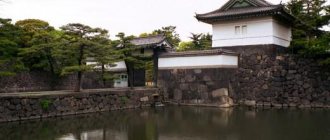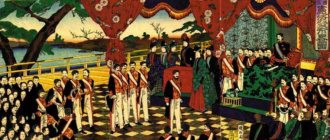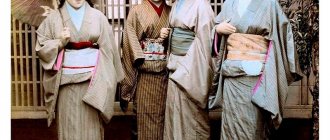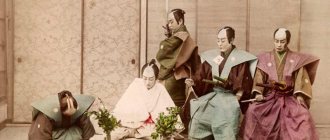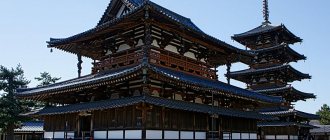From hostage to ruler of the Middle Kingdom
Tokugawa Ieyasu was born in 1543, his father was the ruler of the Mikawa province, Matsudaira Hirotada, who lived in Okazaki Castle. At the age of 6, he was sent as a hostage to the Oda family in Owari, and then he lived as a hostage with the daimyo of the provinces of Suruga and Totomi Imagawa Yoshimoto. During this time, his father was killed by one of the vassals, Okazaki Castle came into the actual possession of Imagawa, and Ieyasu began to fight in his army.
G. Okazaki in the prefecture Aichi, homeland of Ieyasu. On the left is Okazaki Castle, where Ieyasu was born, on the right is the statue of Ieyasu in Okazaki Park (courtesy of the Okazaki City Administration)
However, at the Battle of Okehazama, Imagawa Yoshimoto was killed, thanks to which Ieyasu decided from the Imagawa family to join forces with the ruler of Owari, Oda Nobunaga, subjugated the province of Mikawa and became one of the daimyos of the Warring States era. Subsequently, Takeda Shingen entered into an alliance with him, with whom they destroyed the Imagawa clan, and Ieyasu received the Totomi province, and then he took the Suruga province from the Takeda clan. After the Honnōji Temple incident, when Oda Nobunaga died, he captured the provinces of Kai and Shinano, the former domains of the Takeda. For some time he was at enmity with Toyotomi Hideyoshi, but later became his vassal and helped him in his administration. After the fall of the Hojo clan from Odawara, Hideyoshi sent him to rule the Kanto region, and from then on Ieyasu settled in Edo.
However, after the death of Hideyoshi, the head of the Council of Five Elders (go-tairo) Ieyasu began to arbitrarily enter into marriage alliances with other daimyo and distribute rewards, which caused discontent among others. In 1600, Ishida Mitsunari, one of the Five Governors (go-bugyo), along with Mori Terumoto, one of the Five Elders, gathered troops to finish off Ieyasu.
When the troops of the West, led by Mitsunari, met at Sekigahara with the army of the East Ieyasu, in just a few hours Ieyasu won, and the defeated Mitsunari was executed in Kyoto. After the end of hostilities, Ieyasu took possessions from 93 daimyo of the losing side with a total income of more than 5 million koku of rice (1 koku - about 180 liters), generously giving lands to the tozama daimyo who acted on his side (who became Tokugawa vassals after the Battle of Sekigahara) . However, at the same time, many of them had to change their possessions, moving to remote provinces, and shimpana (Tokugawa relatives) and fudai-daimyo (long-time Tokugawa vassals) were appointed to the regions of large cities (Edo, Osaka) and in important areas of transport routes. This was done so that the Tozama, having rebelled, could not quickly capture Osaka or Edo.
Site of the Battle of Sekigahara (PIXTA)
Tokugawa Ieyasu: Hostage, Shogun, God (Part 1)
Nobunaga Oda: “If he doesn’t sing, I’ll kill the nightingale!” Hijoshi Toyotomi: “We need to make him sing!”
Izyasu Tokugawa: “I’ll wait until he starts singing...”
(An ancient Japanese parable about how three great men stood under a tree on which a nightingale sat)
So we have finally come to the story of a man with a unique fate even by Japanese standards. A man of not very significant family, who was held hostage since childhood, but by the will of fate and his talents became the ruler of Japan and declared a deity after his death. Moreover, he not only achieved the highest power in the country, after the emperor, and quite real, not nominal power, but also passed it on to his children, establishing the rule of the Tokugawa clan in Japan for... 265 years! That’s exactly how long, from 1603 to 1868, the shoguns of his family ruled in the country, ensuring peace, preservation of culture, traditions and complete economic stagnation, which almost turned into a national disaster and complete loss of independence!
This is how Ieyasu Tokugawa looks in the Japanese painting tradition.
But he, of course, could not know what his “now” would lead to for his descendants. He just wanted the best for them and for the country. Note that in the history of different countries of the world there were quite a lot of rulers, to whose name the word “Great” was then added. But what does it mean for a ruler to be great? Well, first of all, probably, the ruler must unite the country or the territories under his control into one economic and cultural whole and, note, many have managed to do this. This is Cyrus the Great, and Alexander the Great, and Peter the Great, and Catherine the Second, and Joseph Stalin - why not? We are unlikely to be mistaken if we add that such a ruler had to fight happily and either push the limits of his own power, or defend its territorial integrity in the fight against the enemy. And here we meet all the same names. But such an important condition for “greatness” as continuity of one’s course is an unattainable dream for most of the above-mentioned historical characters. Well, they did not pay the necessary attention to this most important circumstance. Alexander died, and immediately his closest associates tore the empire apart, and his mother, wife and son were killed. Peter the Great died, having written: “Give everything...” and nothing more. Catherine was succeeded by Pavel, who began to do everything his own way and ended up getting hit in the temple with an ashtray. Well, the no less great Stalin ended his life alone, surrounded by half-friends, half-enemies, and left not only an heir (his son Vasily does not count, of course, he is a son, not an heir!), but also a successor to his work. Why this happened is the topic of a separate article. The main thing is that it happened. Well, the empire he created also turned out to be short-lived, although it survived the greatest of wars.
And so in the series “Nayotora, Mistress of the Castle”.
But Tokugawa Ieyasu did not receive the nickname “The Great” during his lifetime. But after his death, he was awarded the name Tosho-Daigongen (“Great Savior God who illuminated the East”), under which he was included in the list of spirit-deities of the kami. Of course, it is not entirely correct to compare the characters we named directly like this. Many had different tasks, they lived in different eras with different levels of technology, but... nevertheless, the stability of the Tokugawa shogunate is still indicative: 265 years of rule by representatives of the same family! Moreover, he did not have a theory that would unite the masses, it was not true to its ideas and to himself, the party, but there were only adherents bought for rice rations and an oath of allegiance, there were no media trusted and controlled by him, there was a lot of things . And yet, he succeeded in something that no one in Japan had managed before! Yes, there were shoguns before Ieyasu Tokugawa, but their clans still did not rule for so long! Thus, the first Minamoto shogunate in Japan lasted 141 years. Also a considerable period, but still less than the second Ashikaga shogunate, whose reign lasted 235 years, but again was shorter than the term of the last, third, with its capital in Edo. And this despite the fact that Ieyasu himself was shogun for only two years! In 1603 he received this title, and in 1605 he passed it on to his son Hidetada. Having given the Japanese the peace and stability they desired, Tokugawa died in 1616.
Mother of Ieyasu Tokugawa.
Naturally, the life of such a person is of great interest and that is why we will tell you about him...
Tokugawa Ieyasu was born in 1543, belonged to the Matsudaira samurai family - ancient, but seedy. His father was Matsudaira Hirotada, the eighth head of the Matsudaira clan and daimyo of Mikawa Province. As a child, Ieyasu bore the name Takechiyo and very early on experienced what it meant to be a member of a weak family. The fact is that the lands belonging to the Matsudaira clan were so poorly located that to the east and west of them there were much more powerful neighbors who were constantly at war with each other. That is why, perhaps, the main occupation of the clan members was arguing about whose ally it was best to become, that is, simply put, to whom and for what to sell with the greatest profit! Some of the clan’s vassals “sided” with their western neighbor Oda Nobuhide, but others advocated submission to the daimyo located in the east - Imagawa Yoshimoto. Ieyasu's grandfather Matsudaira Kiyoyasu (1511-1536), in one of the quarrels over the choice of overlord, was even stabbed to death by his own vassals, because he wanted to contact the Oda family, and they wanted to see the Imagawa family as overlord. Therefore, the father of the future unifier of Japan had to be very careful not to repeat his fate! By the way, Ieyasu’s mother was from a family that usually adhered to an orientation toward its western neighbors, so when in 1545 most of the vassals of the Matsudaira clan began to insist on supporting Imagawa Yoshimoto, he had to expel her from his residence. The opinion of relatives and vassals turned out to be stronger than his power as the head of the clan!
Imagawa Yoshimoto. U-kiyo Utagawa Yoshiiku.
When the Oda army attacked the lands of the Matsudaira clan in 1548, he asked for help from the powerful daimyo Imagawa Yoshimoto. And he, of course, agreed to help his vassal on the condition that the young Ieyasu be handed over to him as a hostage. This automatically placed the Matsudaira clan in a subordinate position. But Ieyasu’s father had no choice, and he agreed. But then began a story worthy of Golluvid action films, but nevertheless quite reliable. Oda Nobuhide learned of Hirotada's intention to give away his son Imagawa and thus buy his military support and... organized the kidnapping of six-year-old Ieyasu, using secret agents for this. He reasoned quite logically - no son, no hostage, and no hostage, then there is no alliance, because Imagawa will simply decide that Ieyasu is being hidden from him!
But it turned out that the duty of the head of the clan for Hirotada turned out to be higher than his father’s love and he decided that his son could be sacrificed, but a military alliance could not. And Nobuhide's plan thus failed. In theory, he should have killed Ieyasu immediately, but he decided that it was never too late to do this and sent the boy to Manshoji Monastery in the city of Nagoya ahead of time, where he kept him for three years. And it turned out that during this time the future shogun became friends with Oda Nobunaga, the son of his captor!
Image of Ieyasu Tokugawa's helmet.
And in 1549, Matsudaira Hirotada, Ieyasu’s father, was stabbed to death by his own guard, and thus the Matsudaira clan found itself without a leader - a situation, again, very realistically shown in the series “Nayotora, Lady of the Castle.” According to the concepts of that time, Imagawa Yoshimoto sent his man to their castle, who was supposed to lead the clan on his behalf. But the duty of the samurai commanded that Ieyasu be snatched from Oda’s hands and made him the new head of the clan. And such an opportunity for Imagawa presented itself three years later, when Oda Nobuhide died of an ulcer, and now internal strife and struggle for leadership began in his clan. Taking advantage of this, the Imagawa troops captured the castle, and in it the son of the late Nobuhide, Oda Nobuhiro, whom it was decided to exchange for nine-year-old Ieyasu. The vassals of the Matsudaira family were very pleased with the return of the new master, even if he was young, but Imagawa Yoshimoto insidiously deceived their expectations and took Ieyasu to his capital, the city of Sunpu. That is, he again became a political hostage, only now with another person. But what to do if in Japan the nobility usually did not stand on ceremony with the small landed nobility (and, by the way, where did the nobility at least stand on ceremony with someone?!) And in order for its samurai to remain faithful to their daimyo, they took hostages from their families. Usually the eldest sons are the heirs who then lived at the court of the “senior master.” So young Ieyasu thus became a hostage in the Imagawa clan. But he lived well there: food, training from one of the best strategists of that time, Ohara Yusai, clothing and accommodations befitting his position - he had all this. In 1556, Imagawa Yoshimoto became his adoptive father and even personally performed the coming-of-age ceremony for the young hostage. Ieyasu received the name Matsudaira Jiro Motonobu. The next year, he actually forced him to marry his niece named Sena, that is, made the hostage his relative, and gave him a new name Motoyasu. Then another year later, Imagawa gave Ieyasu command of the troops, which he successfully commanded in his first battle, capturing Terabe Castle on the western border for Imagawa. All this time, Ieyasu was smart enough to pretend to be such a simpleton (by the way, in the series “Nayotora, Lady of the Castle” this is also shown very well!), constantly playing go (a popular game in Japan, like chess) with himself. That is, his personality did not arouse much envy among anyone in the Imagawa family.
Go table used by Ieyasu.
But he pretended to be stupid only until the Battle of Okehazama (1560), in which the head of the clan, Imagawa Yoshimoto, died. Knowing well that the son of Yoshimoto Ujizane is very far from his father in all respects, and his own troops are at his fingertips, Ieyasu decided to rebel against his overlord as soon as he learned of the death of Yoshimoto in the Battle of Okehazama, and to enter into an alliance with his worst enemy (and friend!) – Oda Nobunaga!
In order to be free in all respects, he managed to take his wife and son out of Sunpu, and then capture his ancestral Okazaki castle. Only after this, in 1561, Ieyasu decided to openly oppose the Imagawa clan, after which he stormed one of their forts. The following year, 1562, he finally concluded an alliance with Oda Nobunaga, under which he promised to fight his enemies in the east. And a year later, as a sign of a complete break with the Imagawa clan, he again changed his name and began to be called Matsudaira Ieyasu.
After this, Ieyasu took up the affairs of government in his lands, but in this he began to be hindered by the Buddhist communities of fanatical monks of the Ikko-ikki sect, who did not recognize his authority. He had to fight with them from 1564 to 1566, but, fortunately, for Ieyasu this war ended with his complete victory for Ieyasu. He united all the lands of Mikawa Province under his control, for which the imperial court awarded him the honorary title "Mikawa no kami" (Protector of Mikawa). Only now did he feel truly strong and once again changed his surname to Tokugawa - the surname of the descendants of the ancient samurai family of Minamoto.
In 1568, Ieyasu decided to enter into an alliance with another neighbor, already in the north - the Takeda clan, but again against the Imagawa clan. In addition, he also participated in Oda Nobunaga's campaign against Kyoto, and assisted Ashikaga Yoshiaki, who received the position of shogun.
Takeda Shingen at that time was a powerful ally with a strong army. Therefore, it is not surprising that under the general blows of Shingen and Tokugawa, the Imagawa clan ceased to exist. Totomi Province (the western part of modern Shizuoka Prefecture) now belonged to Ieyasu, and Shingen received Suruga Province (the eastern part of modern Shizuoka Prefecture). However, their interests diverged further. Takeda wanted to capture Kyoto, but the Tokugawa clan prevented him from doing so. Therefore, Shingen decided to destroy it and in 1570 invaded the possession of Ieyasu, who at that time was helping Oda Nabunaga fight the Sakura and Azai clans.
Battle of Mikatagahara. Triptych by Chikanobu Toyohara, 1885
Tekeda Ieyasu successfully repelled the first blows. But in October 1572, Takeda Shingen personally led his troops into battle. Tokugawa had to ask for help from Oda Nobunaga, but he was completely absorbed in the war with the Azai, Asakura clans and Buddhist rebels, and was unable to provide assistance to Ieyasu and had to act independently. He lost the Battle of Ichigenzaka, which was the signal for his vassals to defect to Takeda Shingen. The situation became especially aggravated when the Futamata fortress fell and Ieyasu's allies began to abandon him one by one. Seeing the plight of his ally, Oda Nobunaga sent him three thousand warriors. But still, having 11 thousand soldiers, Ieyasu simply could not win another battle with the 25 thousand-strong army of Takeda Shingen. Nevertheless, Ieyasu Tokugawa nevertheless decided to give the aggressor a “last battle” and on January 25, 1573, attacked him from the rear. But even this cunning maneuver did not bring him success. As a result, the Battle of Mikatagahara ended in a crushing defeat for Ieyasu's army. He barely managed to escape from the encirclement and return to his castle. In the film “Naiotora, Mistress of the Castle” it was shown that at the same time he also shit his pants and, in principle, after the horror he experienced after this battle, this was quite possible!
The famous screen from the Ieyasu Tokugawa Museum depicting the Battle of Nagashino.
A fragment of a screen on which in the lower left corner there is an image of Ieyasu’s faithful associate Honda Tadakatsu, who can be recognized by his helmet with deer antlers.
But as it is written in the chronicles of that era (and this was actually the case, who would doubt it!) “the kami did not leave Tokugawa,” because when everything seemed to be lost for him, Takeda Shingen suddenly fell ill in February 1573 and died. Tokuga was at first so confused that he did not believe this news and in May of the same year he tried to take back a number of fortresses and castles that Shingen had captured in his lands. The response was complete silence, since Shingen’s son Katsuyeri was very far from his father, which he later demonstrated in the Battle of Nagashino. And of course, many of those local rulers who had only yesterday sided with Takeda immediately ran to express their submission to Ieyasu. So there could be no doubt - the great Takeda Shingen really died!
The Japanese are very careful about the memory of historical events that took place on their land. Here, for example, is a photograph from the Museum of the Battle of Nagashino, which shows a model of the fortifications built there.
And these are real fences installed at the battle site. Nothing special, but... visible and memorable!
It was not until May 1574 that Takeda Katsuyori decided to finally implement his late father's plan and capture the capital of Kyoto. With an army of 15 thousand, he invaded the lands of Tokugawa and captured the high-mountain castle of Takatenjinjo. In theory, he should have developed his success after that, but... that was not the case. For some reason, he spent a whole year there, and in the meantime the united armies of Oda Nobunaga and Tokugawa Ieyasu opposed him. On June 29, 1575, at the Battle of Nagashino, they completely defeated the army of the Takeda clan, shooting his cavalry with muskets. Many generals and many samurai and ashigaru died. Thus, Ieyasu again regained power over all (except Takatenjinjo Castle) lost possessions, and the complete liquidation of the Takeda clan was now just a matter of time.
To be continued…
Creation of a system of inheritance of power
So Tokugawa Ieyasu became the sole ruler of the country, and in 1603 received from the emperor the title seii-taishogun (“great commander who pacified the barbarians,” more often than not simply shogun), after which he officially established the government of the military class of bakufu in Edo. The forces of shimpan, fudai, jikishin (direct vassals, hatamoto and gokenin) under Ieyasu numbered more than 200,000 people, making him the undisputed military overlord.
At the same time, in creating the political system, his advisers were people who had managed the affairs of the clan since the time of his life in Mikawa, such as daimyo Honda Masanobu, the monk of the Nanzenji temple Konchiin Suden, and the Confucian Hayashi Rajan, among whom he distributed administrative responsibilities. The complex political system of the shogunate was finally formed under his grandson Iemitsu.
In 1603, Ieyasu ordered all daimyo of the country to take part in the construction work of an unprecedented scale of tenka beads, equipping Edo Castle and the surrounding areas. The filling of Hibiya Bay was carried out, creating wide dry areas, and the construction of the Onagigawa and Dosambori waterways. In addition to providing water transportation, infrastructure was created for land transport - the Five City Routes of Gokaido, starting from Nihonbashi and inns along them. As a result of these activities, by the end of Ieyasu's life, Edo had become a large city, home to several tens of thousands of people.
In 1605, just two years after receiving the title of shogun, Ieyasu ceded it to his son, and Hidetada became shogun - this was done to demonstrate the succession of the shogun title in the Tokugawa family, but Ieyasu still controlled the country's politics from his residences in Fushimi and Sumpu castles .
Destruction of the Toyotomi clan
After the Battle of Sekigahara, Hideyori, the son of Toyotomi Hideyoshi, reduced to the rank of one of the daimyos, continued to own Osaka Castle and rule the lands in the provinces of Settsu, Kawachi and Izumi with a total income of 600,000 koku. Many daimyo sympathized with the Hideyoshi family, and when Ieyasu met Hideyori in 1611 after a long break, he discovered that he had become a smart young man. Since then, Ieyasu, who sought to ensure the preservation of the power of the Tokugawa clan, decided to get rid of Hideyori.
The Toyotomi clan restored the Hokoji Temple in Kyoto, which was revered by Hideyoshi, and an inscription was made on the temple bell, including the phrases “Peace and prosperity to the country, prosperity and joy to the lords and vassals” (kokka anko, kunshin horaku, 国家安康、君臣豊楽) . Ieyasu accused Toyotomi that the inscription was hiding a curse, since the characters for his name 家 and 康 contained in the inscription were separated. Under this pretext, in 1614 he besieged Osaka Castle with an army of two hundred thousand. Thus began the Winter Osaka Campaign, which ended in the 12th lunar month with a truce, but in 1615 Ieyasu again moved troops, and as a result of the Summer Osaka Campaign, Hideyori committed suicide, and the Toyotomi clan was extinguished.
That same year, Ieyasu issued a decree stating that there could only be one castle per province. The decree was aimed at weakening the daimyo of the western provinces, who could retain their residences, but had to destroy other castles. Even that year, on behalf of the shogun Hidetada, the Code of Laws of Military Houses (Buke Shohatto) was published, which contained strict restrictions on the activities of daimyos, including prohibiting unauthorized marriage and building new castles.
Absolute control
Thus, through military force and new laws, Ieyasu limited the daimyo's ability to act, but control was required not only over them - Ieyasu sought to suppress any forces that could threaten his power, including the imperial court.
Formally, the power of the Edo bakufu was based on the fact that the emperor granted the head of the Tokugawa clan the title of shogun, endowing him with authority. For this reason, Ieyasu showed respect to the imperial court, and due to the decrease in the court's holdings during the Warring States era (1467-1568), in 1601 he presented the imperial court with lands yielding 10,000 koku of rice. However, the management of the possessions of the imperial house was carried out by the bakufu itself. In addition, to supervise the daimyo of the western provinces and the imperial court, the position of shoshidai, the viceroy of the shogun in Kyoto, was established, who constantly monitored the actions of the court and aristocratic families. In addition to this, two people were appointed buke tenso, envoys of the military houses - they conveyed the orders of the bakufu (transmitted through the shoshidai) to the court. They were chosen from among the aristocracy, and their salaries were paid by the shogunate.
In 1613, laws were passed defining the behavior of the aristocracy, which were ordered to deal with the protection of the palace and the affairs traditional for these families. The laws established in 1615 for the court and aristocracy determined the functioning of the palace, the life of the emperor and courtiers, seniority among the aristocracy and the procedure for promotion. All this was done so that the court and the emperor would lose all political influence.
The warrior monks (sohei) of the monasteries of Mount Hiei and Koya and the followers of the Ikko school during the Warring States period were a force that could crush the armies of daimyo, which is why Ieyasu began to introduce a system of restricting the activities of shrines, monasteries and Buddhist armies in 1615, adopting the Code laws on monasteries (Dziin-hatto).
Anti-Europeanization of Japan and the “Edict of Restriction of Maritime Shipping of 1639”[edit]
Main article: Sakoku Decree of 1635
In the 16th century, Japan was among the Asian countries that most attracted European traders and missionaries. A group of Portuguese arrived on the island of Tanegashima, becoming the first Europeans to enter Japan. Thus began the period of the so-called Nanban trade.
(南蛮貿易
Nanban bōeki
).
From 1545, many European ships arrived in Japan, first from Portugal and then from Spain, the Netherlands and England. Beginning in 1549, with the arrival of Francis Xavier in Kagoshima, a large missionary campaign led by the Society of Jesus began to shake up the social structures of Japan. Also, on the island of Kyushu, in order to maintain European trade in their lands, some daimyo
agreed to convert to Christianity. By the early 17th century, half a million Japanese (out of a population of 11 million) had converted to Christianity.
However, during the period of Europeanization, hostile sentiments towards foreigners began to spread throughout Japan. After the Spanish conquest of the Philippines between 1565 and 1597, Toyotomi Hideyoshi, the highest military/political authority in Japan at the time, began to more strongly doubt the good intentions of Europeans and question the loyalty of Christian daimyo
.
Seeing the threat that Christianity potentially posed to political stability as well as to the daimyo
's loyalty to the Church, he issued anti-Christian decrees, expelling foreign missionaries and ordering the crucifixion of a number of prominent Catholic proselytizers and converts. However, it was only during the reign of Tokugawa Iemitsu that anti-Christian policies became more widespread and carried out for a longer period of time.
The centuries-long presence of Catholic traders and missionaries in Japan ended in the 1630s, when Iemitsu ordered the expulsion of almost all Europeans from the country. European access to trade relations with Japan was limited to one Dutch ship per year. Iemitsu's policy in this matter was strengthened after the execution of two Portuguese who had come to ask for the restoration of Japan's previous foreign trade policy. By the late 1630s, Iemitsu issued a series of decrees detailing a system of restrictions on the flow of people, goods, and information into and out of the country.
The most famous of these decrees was the so-called Sakoku Decree of 1635. It contained the major restrictions imposed by Iemitsu. With this, he prohibited all Japanese ships and people from traveling to another country or returning to Japanese shores. The penalty for violation was death. The decree offered generous gifts and rewards to anyone who could provide information about the priests and their followers who secretly practiced and spread their religion throughout the country. In addition, each newly arrived ship was required to be carefully checked for the presence of Catholic priests and followers. The document pays very close attention to every detail regarding visiting foreign ships. For example, merchants arriving from abroad were required to provide a list of the goods they were bringing with them before they were granted permission to trade. Additional provisions clarify the timing and logistics of trade. For example, one clause states that “the sailing date for foreign ships shall not be later than the twentieth day of the ninth month.” In addition to this, Iemitsu prohibited changes in the set price of raw silk and thus ensured that competition between trading cities was kept to a minimum.
The measures taken by Iemitsu were so powerful that it was not until the 1850s that Japanese ports opened to a wider range of trading partners, Westerners were free to settle and travel throughout Japan, and Japanese were free to travel abroad again. This period of "sea restrictions", from the 1630s to the 1850s, as described above, is very often called sakoku
or “closed country”, but many scientists [
who?
]today I oppose the idea that Japan was “closed.” They argue that Japan's international relations policy during this period should be understood, rather, as simply aimed at keeping international interaction under tight control; Moreover, they emphasize that Japan was not the only one who sought to control and limit international interaction, and that in fact almost every major power at the time had policies dictating who could trade in which ports, at what times, and at what times. how. [7]
Economic activities of Ieyasu
What was the economic basis of the bakufu's power?
The main income was taxes from bakufu lands, bringing up to 4 million koku of rice per year. Responsible for paying taxes and performing work were the peasants who owned flooded and dry fields, estates, and were entered into the registration books as hombyakusho, “chief peasants.” In the book of teachings for the military class, Evening Tales of Peaceful Times (Shohei Yawa), written by Takano Tsunemichi in 1796, Ieyasu allegedly said that taxes should be collected so that the peasants in the villages and villages do not die, but also were not very alive. It seems that Ieyasu's policy was to collect an annual tax so that the peasants could not acquire new property, but would not starve. He directly controlled important cities - Edo, Osaka, Kyoto, Nagasaki, Sakai and others, and especially from the monopoly trade in Nagasaki, after his death the bakufu received good income.
As in the time of Toyotomi Hideyoshi, the government received profits from the mines that were in its ownership, but Ieyasu began a new business - minting money from the gold and silver that was mined. Gold money mints were established in Edo, Sumpu, Kyoto, Sado Island and other places, silver money was made in Fushimi, Edo, Sumpu, Kyoto, etc., then a lot of “gold and silver money of the Keicho years” were produced. (keicho kingin). Japan had previously used Chinese copper money, a move that marked a major milestone in the country's financial policy.
Foreign policy as a tool for generating income
Next we will look at Ieyasu's foreign policy.
Ieyasu pursued an active foreign policy. When the Dutch ship De Liefde ran aground in Usuki Bay, Bungo Province (present-day Oita Prefecture), Ieyasu met with the mate, the Dutchman Jan Joosten van Lodenstein, and the navigator, the Englishman William Adams (later Miura Anjin). He invited them to Edo and consulted on foreign policy issues, encouraging relations with the Netherlands and England. He knew that both countries were Protestant, in contrast to Catholic Spain and Portugal, where trade was inseparable from missionary activity. Thanks to this, trading posts were opened on the island of Hirado: in 1609 - Dutch, in 1613 - English.
Image by Jan Joosten van Lodenstijn near Tokyo Station (© Photo Library)
At that time, the Portuguese, based in Macau, bought raw silk from China and sold it to Nagasaki at a huge profit. To curb the monopoly trade of the Portuguese, Ieyasu in 1604 established an organization of government-approved itowappu intermediaries operating in Kyoto, Sakai and Nagasaki, who determined the price of silk, delivered annually in the spring, purchased all the goods, and then distributed among themselves.
In 1610, Kyoto merchant Tanaka Shosuke, on Ieyasu's orders, visited the Spanish territory of New Spain (present-day Mexico), where he asked for the resumption of trade with Luzon (now the Philippines), which had ceased after Toyotomi Hideyoshi executed 26 missionaries and their followers.
Ieyasu also ordered the So family on Tsushima to restore relations with Korea that had been interrupted by the military invasion of the Korean Peninsula. The So family achieved this in 1607, after which they began sending tsushinshi envoys from Korea with gifts when changing shoguns. The Chinese Ming Empire, which participated in the Korean War, did not officially resume relations, but merchant ships from China often came to Hirado, Nagasaki and other Japanese ports.
Ieyasu actively developed overseas trade using diplomatic means, but in the last years of his life everything changed. If he had previously turned a blind eye to the spread of Christianity, in 1612 he banned this religion in the territories under direct control, and the following year extended the ban to the entire country, while simultaneously ordering the destruction of churches and forcing followers to completely abandon the faith - probably fearing invasions by the Spanish or Portuguese, with whom Christian groups in Japan might have united. In 1614, Takayama Ukon and more than 300 Christians were exiled to Manila and Macau. Such changes in policy may have been aimed at ensuring that Holland and England took the place of the departed Portuguese and Spaniards in trade with Japan. Hidetada, the second shogun, further tightened restrictions, and the third shogun, Iemitsu, completed the system of isolating the country.
Shogun (1632–1651)[edit]
Hidetada left his advisers, the veteran daimyos
, act as regents of Iemitsu.
In 1633, after the death of his brother, Iemitsu dismissed these men. Instead of his father's advisers, Iemitsu appointed childhood friends. With their help, Iemitsu created a strong centralized administration. This made him unpopular with many daimyo
, but Iemitsu simply eliminated his opponents.
His sankin-kotai
forced
daimyo
to live in Edo in an alternating sequence, spending a certain amount of time in Edo and a certain amount of time in their home provinces.
It is often said that one of the key goals of this policy was to prevent the daimyo
from accumulating too much wealth or power by separating them from their provinces and forcing them to regularly set aside a significant sum to finance the enormous travel expenses involved.
with a trip (along with a lot of surroundings) to Edo and back. The system also involved Daimyos
' wives and heirs remaining in Edo, detached from their lord and from their home province, serving mainly as hostages who could be harmed or killed if
the daimyo
were to
formulate a plan
to rebel against the shogunate. [5]
In 1637, an armed revolt arose against Iemitsu's anti-Christian policies in Shimabara, but there were other reasons involved, such as excessively high taxes and mistreatment of peasants by the local lord. The period of internal unrest is known as the Shimabara Rebellion. [1] Thousands were killed during the shogunate's suppression of the rebellion, and countless numbers were executed subsequently. [6] The fact that many of the rebels were Christians was used by the bakufu as a convenient excuse to expel the Portuguese and limit the Dutch East India Company to Dejima in Nagasaki.
During the 1630s, Iemitsu issued a series of edicts restricting Japan's relations with the outside world. The Japanese, who had traveled extensively throughout East and Southeast Asia (and, in rare cases, much further afield) since the 1590s, were now prohibited on pain of death from leaving or returning. Europeans were expelled from the country, except for those associated with the Dutch East India Company, who were confined to the artificial island of Dejima in Nagasaki harbor. Japan remained highly connected to international trade, information, and cultural exchange, although only in four areas. Nagasaki was a center for trade and other transactions with the Dutch East India Company and independent Chinese merchants. Satsuma controlled relations with the Ryukyu Kingdom (and, through the Ryukyu, had access to Chinese goods and information, as well as products from far abroad through alternative trade routes that passed through the Ryukyu), while the Tsushima Domain handled diplomatic and trade relations with Joseon. dynasty Korea and the Matsumae Domain controlled communications with the Ainu, the indigenous people of Hokkaido, Sakhalin and the Kuril Islands, as well as limited communication with related peoples on the mainland near Sakhalin. Japan during this period was often described as "closed" or under sakoku
(鎖国, "chained country"), but since the 1980s, if not earlier, scholars have advocated the use of terms such as "sea restrictions" or
kaikin.
(海禁, "sea restrictions"), emphasizing the fact that Japan was not "closed" to the outside world, but was in fact very active in interacting with the outside world, albeit in a limited set of ways. [7]
In 1643, Empress Meisho abdicated the throne. She was succeeded by her younger half-brother (Go-Mizuno's son by her husband), Emperor Go-Komyō, who disliked the shogunate for its cruel and barbaric methods. He repeatedly made insulting comments towards Iemitsu and his eldest son and heir, Tokugawa Ietsuna.
In 1651 the shogun
Iemitsu died at the age of 47, being the first Tokugawa
Shogun
whose reign ended with death rather than abdication. He was posthumously given the name Taiyuin, [1] also known as Daiyuin (大猷院) and was buried at Taiyu-in Temple, Nikko. [8] He was succeeded by his eldest son and heir, Tokugawa Ietsuna.
